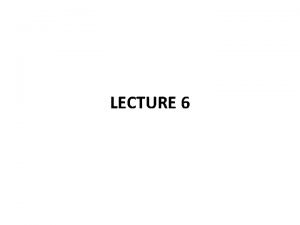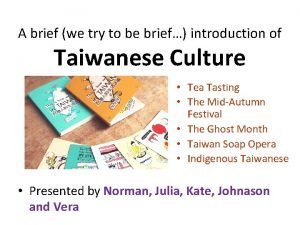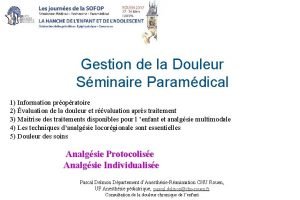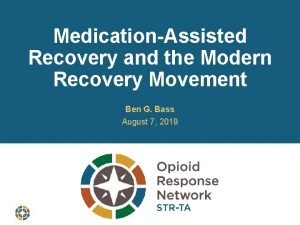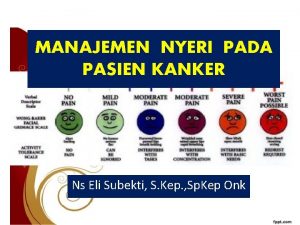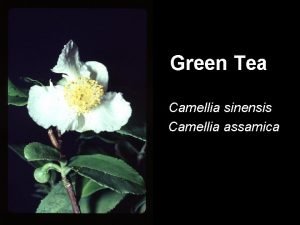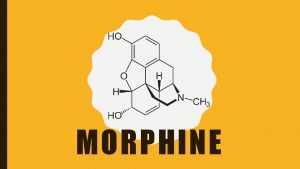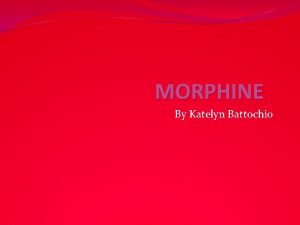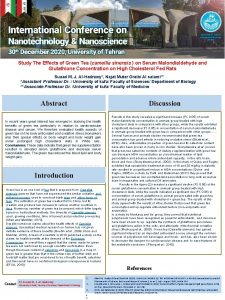Morphine Caffeine Plant Tea Camellia sinensis and others







- Slides: 7

Morphine Caffeine Plant: Tea (Camellia sinensis) and others Plant: Opium poppy (Papaver somniferum) Use: central nervous system stimulant Use: analgesic C 8 H 10 N 4 O 2 Molecular weight (g): Toxicity (LD 50 mouse mg/kg): 62 Cost per 100 mg (£): Molecular formula: Molecular weight (g): 194. 2 Toxicity (LD 50 mouse mg/kg): Credit: ykanazawa Credit: nchenga Molecular formula: Cost per 100 mg (£): 1. 25 Did you know? Plants like tea and coffee produce caffeine as an insecticide to poison bugs which try to feed on the leaves. C 17 H 19 NO 3 285. 3 135 14. 77 Did you know? Laudanum, a potent painkilling medicine made from opium poppies, is documented as far back as 1522 Cocaine Nicotine Plant: Coca plant (Erythroxylum coca) Plant: Tobacco (Nicotiana tabacum) Use: local anaesthetic, stimulant Use: stimulant, insecticide Credit: moche Credit: iheartpandas Molecular formula: Molecular weight (g): Toxicity (LD 50 mouse mg/kg): Cost per 100 mg (£): C 17 H 21 NO 4 303. 4 16 4. 39 Did you know? The original 1886 recipe for Coca-Cola included “a pinch of coca leaves” meaning, until 1906, it contained some cocaine! Molecular formula: Molecular weight (g): C 8 H 14 N 2 162. 2 Toxicity (LD 50 mouse mg/kg): 0. 3 Cost per 100 mg (£): 0. 73 Did you know? Nicotine is more toxic than cocaine or heroin and smoking 40 cigarettes could be deadly (not to mention silly!) for a non-smoker Science & Plants for Schools (www. saps. org. uk) This resource was created by Dr Sarah Mc. Lusky, lecturer in biochemistry at Newcastle College (details correct as of 2012)

Codeine Taxol Plant: Pacific yew tree (Taxus brevifolia) Plant: Opium poppy (Papaver somniferum) Use: chemotherapy (breast cancer) Use: analgaesic Molecular weight (g): Toxicity (LD 50 mouse mg/kg): Cost per 100 mg (£): C 47 H 51 NO 14 Credit: ykanazawa Credit: : pellaea Molecular formula: C 18 H 21 NO 3 Molecular weight (g): 853. 9 299. 4 Toxicity (LD 50 mouse mg/kg): 12 54 Cost per 100 mg (£): 75. 03 Did you know? Taxol is also made by a fungus which lives in the tree bark. It is produced commercially in mixed plant/fungal cell cultures. 0. 53 Did you know? Codeine is the world’s most widely used opiate drug. It is made by methylating the more abundant drug, morphine. Quinine Digoxin Plant: Cinchona tree (Cinchona ledgeriana) Plant: Foxglove (Digitalis purpurea) Use: anti-malaria Use: treating heart arrhythmia Credit: : freefotouk Credit: : USGS Molecular formula: Molecular weight (g): Toxicity (LD 50 mouse mg/kg): Cost per 100 mg (£): C 20 H 24 N 2 O 2 324. 4 68 1. 66 Did you know? Quinine was the first effective treatment for malaria. Tonic water glows under UV light as it contains quinine – go on, try it! Molecular formula: Molecular weight (g): Toxicity (LD 50 mouse mg/kg): Cost per 100 mg (£): C 41 H 64 O 14 780. 9 7. 7 28. 91 Did you know? In 2006 an American nurse was convicted of killing 40 patients with overdoses of digoxin and given 18 life sentences This resource was created by Dr Science & Plants for Schools (www. saps. org. uk) This resource was created by Dr Sarah Mc. Lusky, lecturer in biochemistry at Newcastle College (details correct as of 2012)

Aspirin Ephedrine Plant: ma huang (Ephedra sinica) Plant: Willow tree (Salix alba) Use: stimulant, decongestant Use: analgaesic, blood thinner Molecular formula: C 10 H 15 NO Molecular weight (g): Credit: jimvanmeggelen Credit: alexlomas Molecular formula: C 7 H 6 O 3 Molecular weight (g): 165. 2 138. 1 Toxicity (LD 50 mouse mg/kg): 74 Toxicity (LD 50 mouse mg/kg): 184 Cost per 100 mg (£): 0. 03 Did you know? Ephedrine is closely related to drugs like speed. Ma huang has been used in traditional Chinese medicine for 5000 years. Did you know? Hippocrates, who lived around 400 BC, recorded using a powder made from willow bark to treat pain and fever. Quinidine Strychnine Plant: Cinchona tree (Cinchona ledgeriana) Plant: Strychnine tree (Strychnos nux-vomica) Use: treating heart arrhythmia Use: rat poison Credit: lalithamba Credit: : USGS Molecular formula: Molecular weight (g): C 20 H 24 N 2 O 2 324. 4 Molecular formula: C 21 H 22 N 2 O 2 Molecular weight (g): 334. 4 Toxicity (LD 50 mouse mg/kg): 53. 6 Toxicity (LD 50 mouse mg/kg): 0. 41 Cost per 100 mg (£): 0. 10 Cost per 100 mg (£): 0. 65 Did you know? Quinidine is an isomer of quinine – they have the same chemical formula, but different structures and properties Did you know? Strychnine is the poison of choice in numerous books and films, including the movie ‘Psycho’ and Agatha Christie novels. Science & Plants for Schools (www. saps. org. uk) This resource was created by Dr Sarah Mc. Lusky, lecturer in biochemistry at Newcastle College (details correct as of 2012)

Vinblastine Tetrahydrocannabinol Plant: Cannabis (Cannabis sativa) Plant: Madagascar periwinkle (Catharanthus roseus) Use: analgesic, anti-emetic Use: chemotherapy (leukaemia) Molecular formula: C 21 H 30 O 2 Molecular weight (g): 810. 9 Toxicity (LD 50 mouse mg/kg): 42 Cost per 100 mg (£): C 46 H 58 N 4 O 9 Molecular weight (g): 314. 5 Toxicity (LD 50 mouse mg/kg): Credit: Kew Gardens Credit: M. Martin. Vicente Molecular formula: 15 Cost per 100 mg (£): 123. 65 Did you know? Synthetic tetrahydrocannabinol, known as dronabinol, is available on prescription in the USA for treating anorexia and nausea. Vincristine 119. 41 Did you know? The Madagascar periwinkle was used as a folk remedy for centuries before the active chemicals were isolated in the 1950 s Theobromine Plant: Madagascar periwinkle (Catharanthus roseus) Plant: Cocoa (Theobroma cacao) Use: chemotherapy (leukaemia) Use: diuretic, vasodilator Credit: Steve Linder Credit: Kew Gardens Molecular formula: Molecular weight (g): Toxicity (LD 50 mouse mg/kg): Cost per 100 mg (£): C 46 H 56 N 4 O 10 824. 9 3 579. 73 Did you know? Extracting this drug from the plant is a slow process with low yields, but the molecule is too complicated to make synthetically. Molecular formula: C 7 H 8 N 4 O 2 Molecular weight (g): 180. 2 Toxicity (LD 50 mouse mg/kg): 837 Cost per 100 mg (£): 0. 07 Did you know? Dogs metabolise theobromine more slowly than humans and can be poisoned with just one bar of chocolate. Science & Plants for Schools (www. saps. org. uk) This resource was created by Dr Sarah Mc. Lusky, lecturer in biochemistry at Newcastle College (details correct as of 2012)

Topotecan Reserpine Plant: Snake root (Rauwolfia serpentina) Plant: Happy tree (Camptotheca acuminata) Use: high blood pressure, anti-psychotic Use: chemotherapy (ovarian & lung cancer) C 33 H 40 N 2 O 9 Molecular weight (g): Cost per 100 mg (£): Molecular formula: C 23 H 23 N 3 O 5 Molecular weight (g): 608. 7 Toxicity (LD 50 mouse mg/kg): Credit: scott. zona Credit: kadavoor Molecular formula: 421. 4 Toxicity (LD 50 mouse mg/kg): 21 Cost per 100 mg (£): 390. 34 Did you know? In India, home of the Snake Root plant, this drug has been popular for centuries – even Mahatma Gandhi used it! 7. 5 23, 042. 66 Did you know? Topotecan inhibits the enzyme DNA topoisomerase and stops cancerous cells replicating. Irinotecan Capsaicin Plant: Happy tree (Camptotheca acuminata) Plant: Chilli peppers (Capsicum sp. ) Use: chemotherapy (colorectal cancer) Use: treating nerve pain and arthritis Credit: Ben Geach Credit: scott. zona Molecular formula: Molecular weight (g): Toxicity (LD 50 mouse mg/kg): Cost per 100 mg (£): C 33 H 38 N 4 O 6 586. 7 132 1336. 00 Did you know? Irinotecan and topotecan are derivatives of naturally occurring camptothecin which is used in Chinese herbal medicine. Molecular formula: Molecular weight (g): Toxicity (LD 50 mouse mg/kg): Cost per 100 mg (£): C 18 H 27 NO 3 305. 4 0. 4 62. 40 Did you know? Capsaicin creates a burning sensation on the skin which blocks pain signals – you might have experienced it eating chillies! This resource was created by Dr Science & Plants for Schools (www. saps. org. uk) This resource was created by Dr Sarah Mc. Lusky, lecturer in biochemistry at Newcastle College (details correct as of 2012)

Theophylline Diosgenin Plant: Yams (Dioscorea sp. ) Plant: Tea (Camellia sinensis) Use: contraceptive Use: muscle relaxant and bronchodilator Credit: nchenga Credit: IITA Molecular formula: C 27 H 42 O 3 C 7 H 8 N 4 O 2 Molecular weight (g): 414. 6 Molecular weight (g): Toxicity (LD 50 mouse mg/kg): >8000 Toxicity (LD 50 mouse mg/kg): 136 Cost per 100 mg (£): 3. 17 Cost per 100 mg (£): 0. 74 180. 2 Did you know? If you have asthma a cup of tea might help! Theophylline was developed as an asthma treatment drug in the 1950 s. Did you know? Diosgenin is a precursor of the hormone progesterone and research on this plant in the 1940 s led to the first contraceptive pill Colchicine Tubocurarine Plant: Autumn crocus (Colchicum autumnale) Plant: Curare (Chondrodendron tomentosum) Use: treating gout Use: muscle relaxant, nicotine withdrawal Credit: NTBG Credit: Dietmut Molecular formula: Molecular weight (g): Toxicity (LD 50 mouse mg/kg): Cost per 100 mg (£): C 22 H 25 NO 6 399. 4 1. 7 19. 68 Did you know? Once common, this drug is very toxic and has nasty side effects (like diarrhoea) so is now only used for short term, acute cases Molecular formula: C 37 H 41 N 2 O 6 Molecular weight (g): 609. 7 Toxicity (LD 50 mouse mg/kg): 0. 13 Cost per 100 mg (£): 7. 92 Did you know? South American natives used this plant extract to poison their arrow heads and blow darts when hunting as it paralyses victims. Science & Plants for Schools (www. saps. org. uk) This resource was created by Dr Sarah Mc. Lusky, lecturer in biochemistry at Newcastle College (details correct as of 2012

Heroin Plant: Opium poppy (Papaver somniferum) Plant: Use: analgaesic Use: Credit: ykanazawa Molecular formula: C 21 H 23 NO 5 Molecular formula: Molecular weight (g): 369. 4 Molecular weight (g): Toxicity (LD 50 mouse mg/kg): 21. 8 Toxicity (LD 50 mouse mg/kg): Cost per 100 mg (£): 692. 00 Did you know? Heroin is actually the ‘trade name’ for diamorphine and from 1898 to 1910 could be bought freely as a cough suppressant. Cost per 100 mg (£): Did you know? This resource was created by Dr Science & Plants for Schools (www. saps. org. uk) This resource was created by Dr Sarah Mc. Lusky, lecturer in biochemistry at Newcastle College (details correct as of 2012
